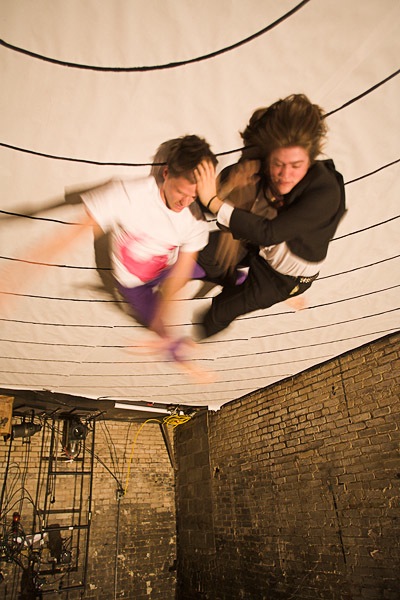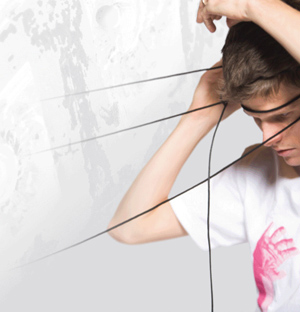The Kinesthetic Pleasure and Aural Intrigue of “RadioBrain”
Camille LeFevre took in last weekend's eagerly anticipated remounting of "the SCREEN/the THING" and "RadioBrain"--a brainy, trippy tour de force of movement and theremin by Justin Jones and Elliott Durko Lynch, recently on stage at the Southern Theater.



AT LONG LAST, A COUPLE OF LOCAL ARTISTS HAVE CREATED A MOVEMENT PIECE incorporating the theramin. Dance artist Justin Jones and performance/sound artist Elliott Durko Lynch brought this early 20th century, space-age-sounding, electronic instrument to kinetic life in their playful, enjoyable geek-fest, RadioBrain, last weekend at the Southern Theater. The theremin is only one of many “instruments” played in the artists’ rather John Cage-ian romp through ideas about time, space, sound, light and movement. The stage is also littered — think controlled chaos — with electrical cords and electronics cables, metal music stands, chairs, rope, microphones, a door, industrial lights, a computer setup, and a cello still in its case, which Jones and Lynch play, or play with, throughout the piece.
And then there’s the theremin (the duo appears to be using an Etherwave-Theremin, probably assembled from a Robert Moog kit), which contains two radio-frequency oscillators that emit signals only heard when intercepted by the human body. Manuals have been written about mastering the theremin. Virtuoso theremin players have made recordings. Avant-garde musicians and composers have integrated the theremin as a centerpiece of their investigations. The instrument’s eerie sound has also become the hallmark of classic sci-fi movie soundtracks, such as the original The Day the Earth Stood Still. Strangely, though, the theremin’s distinctive soundscapes are all too seldom deployed in dance work.
Jones and Lynch seem to simultaneously embrace and shrug off this instrument’s backstory to create a work uniquely their own. Yes, Jones sweeps his arms up, down and through the space, or flutters his hands open and closed, to create the spooky sounds for which the theremin is best known. But the choreographer also thrusts, thrashes, swoops, and steps his body in and out of the wave space, sculpting inaudible, invisible sound into a fireworks display of kinetic physicality and aural intrigue.
That he and Lynch (who might be dashing around the stage checking props, while yelling “delay!” or “amplify!”) are both wearing white undershirts, baggy shorts, crew socks pulled up over their calves, and sneakers, underscores the nerd factor infusing the piece, as well as its humor and, dare I say, its authenticity. Sure, RadioBrain is a somewhat “disjunctive synthesis” (to quote Deleuze and Guattari) of physical, verbal, visual, and auditory stuff, not to mention the pop culture references — note the list of baby-boomer song titles projected on the back wall, as well as the title’s play on the alt-rock band Radiohead.
______________________________________________________
RadioBrain is a Dada-ist collage — pop culture references paired with physical, verbal, visual, and auditory stuff — that refuses to stay within its frame.
______________________________________________________
RadioBrain is also a Dada-ist collage that refuses to stay within its frame – the Southern Theater’s proscenium stage. Jones, holding the end of a white rope, tears up the theater steps and around the audience (he also serenely bobs, like a balloon in the breeze, at the end of it). Kristin Van Loon emerges from the stairwell and recites a nonsense text from behind the audience. But, in the end, RadioBrain is also a window into boys at play. With their jerky sassy movements, geeky sincere intentionality, and complete absorption in a sound/movement/prop/text collage of their own invention, they could be two adolescents (or young Bill Gateses) forming the next-generation basement or garage band.
All of this makes Jones’ recent remount of the 1997 the SCREEN/the THING even more pleasurable than when I last saw it in the 2007 Momentum showcase. In this staging of the production, a collective of human energy particles (Van Loon, Taryn Griggs, Karen Sherman, Morgan Thorson, and Max Wirsing) — in uniforms of black trousers, black wristbands, and bright solid-color shirts — gather together, split apart, and traverse each others’ groupings with a mix of assertive, regimented cadences, space-eating and space-pushing phrases, and calisthenic, kinesthetic movements. It’s exhilarating.
And Lynch’s lush, romantic music gives the movement a mesmerizing undertow that’s violently interrupted by a big bang, a thunderous moment of sound, revealing a parallel universe of dance. Is Jones commenting on aesthetics? Taste? The politics of dance making? The physics of movement, or the dance of particle physics? The history of science? There’s invention and arresting beauty in both the grand, forceful gesture and the delicate, truncated flutter — all reflective of curious intelligence at work.
About the author: Camille LeFevre reviews dance when she feels like it, teaches architectural and dance journalism at the University of Minnesota, and is writing her master’s degree thesis.